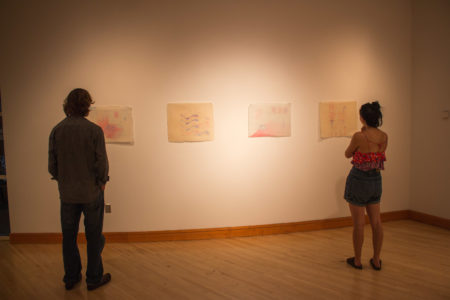
Teresa Fleming
flemingt17@grinnell.edu
The Smith Gallery began this semester’s set of student created shows with Serena Hocharoen’s “it’s a (body)!,” a series of paintings, drawings and zines that bridge the gap between physical and technological experience.
“It’s a show about feelings, both physical and emotional,” Hocharoen said. “I feel like some stuff is lost in the technological world, like we don’t sit down and feel how it is to have a hand that touches things. It’s kind of weird.”
While Hocharoen’s work addresses ambivalence about technology, her process is notably old-school. Each of her pulp paintings and colored pencil drawings are done on handmade paper created by Hocharoen herself. She built on a summer internship experience working for Cave Papers in Minneapolis to hone her skill at a laborious production technique, which involves beating the paper for five hours. Hocharoen said the lengthy process pays off, resulting in a final product with a unique texture.
“The longer you beat the fiber the shorter the fibers get, and then the more transparent and … the easier it is for the fibers to bond to each other,” Hocharoen said. “So that makes the paper more transparent and more tough, and so I used colored pencil on these, and if you look at them, you can see the surface.”
But working with handmade paper also poses a unique set of challenges. Hocharoen noted that her choice of paper also placed some limitations on her creative process.
“I was going to use ink to do it, and it would not work because the paper’s just so sensitive, and they’ll crinkle at any sign of humidity, so some of them have already started to crinkle up because it’s humid outside,” Hocharoen said. “I’m much more careful, which is a really good thing, because planning is important. Planning isn’t something I’m really good at, so it helps me find that process. I think it just makes it more special, because you can’t find this paper at the bookstore. It’s really special to work on handmade paper, because each sheet is individually made, sometimes for a specific drawing.”
Hocharoen’s exhibition builds on her experience producing the zine “Spaghetti Teens,” which has been on hiatus for the past few months as Hocharoen’s efforts were focused on assembling “it’s a (body)!” The show features a display of zines that reflect on relationships with technology.
“I’m used to making zines, and I think without those the show would not have been tied together so well. I like making zines and giving things away for free, and especially giving art away for free,” Hocharoen said.
For Hocharoen, producing zines alleviates some of the pressure associated with creating artwork for exhibition or publication.
“I think having zines just makes me want to make as much as possible,” she said. “For ‘Spaghetti Teens,’ I’ll have a theme and I’ll make a bunch of art pertaining to that theme, and maybe I won’t use all that art, but I’ll have all of this art. It gets you into the mood for creating things. And you should create things even if they’re bad, it’s good practice.”

















































